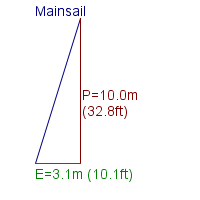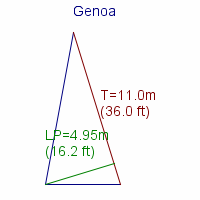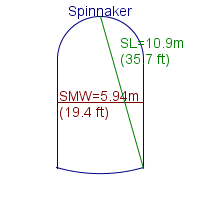Review of OE 29

Basic specs.

If you have a photo you would like to share: Upload Image
Looking for a new boat? Find an OE 29 or similar boat for sale
The hull is made of fibreglass. Generally, a hull made of fibreglass requires only a minimum of maintenance during the sailing season. And outside the sailing season, just bottom cleaning and perhaps anti-fouling painting once a year - a few hours of work, that's all.
The OE 29 is equipped with a masthead rig. The advantage of a masthead rig is its simplicity and the fact that a given sail area - compared with a fractional rig - can be carried lower and thus with less heeling moment.
Unknown keel type
The keel is made of iron. Many people prefer lead keel in favour of iron. The main argument is that lead is much heavier than iron and a lead keel can therefore be made smaller which again result in less wet surface, i.e. less drag. In fact iron is quite heavy, just 30% less heavy than lead, so the advantage of a lead keel is often overstated.
The boat can enter even shallow marinas as the draft is just about 1.45 - 1.55 meter (4.76 - 5.06 ft) dependent on the load. See immersion rate below.
Sailing characteristics
This section covers widely used rules of thumb to describe the sailing characteristics. Please note that even though the calculations are correct, the interpretation of the results might not be valid for extreme boats.
What is Capsize Screening Formula (CSF)?
The capsize screening value for OE 29 is 1.88, indicating that this boat could - if evaluated by this formula alone - be accepted to participate in ocean races.
What is Theoretical Maximum Hull Speed?
The theoretical maximal speed of a displacement boat of this length is 6.2 knots. The term "Theoretical Maximum Hull Speed" is widely used even though a boat can sail faster. The term shall be interpreted as above the theoretical speed a great additional power is necessary for a small gain in speed.
The immersion rate is defined as the weight required to sink the boat a certain level.
The immersion rate for OE 29 is about 117 kg/cm, alternatively 658 lbs/inch.
Meaning: if you load 117 kg cargo on the boat then it will sink 1 cm.
Alternatively, if you load 658 lbs cargo on the boat it will sink 1 inch.
Sailing statistics
This section is statistical comparison with similar boats of the same category. The basis of the following statistical computations is our unique database with more than 26,000 different boat types and 350,000 data points.
What is Motion Comfort Ratio (MCR)?
The Motion Comfort Ratio for OE 29 is 23.0.
What is L/B (Length Beam Ratio)?
The l/b ratio for OE 29 is 3.29.
The ballast ratio for OE 29 is 48%.
What is Displacement Length Ratio?
The DL-ratio for OE 29 is 281 which categorizes this boat among 'medium weight cruisers'.
What is SA/D (Sail Area Displacement ratio)?
The SA/D for OE 29 with ISO 8666 reference sail is 16.4, with a 135% genua the SA/D is 19.4.
What is Relative Speed Performance?
The Relative Speed Performance for OE 29 is 46
Maintenance
When buying anti-fouling bottom paint, it's nice to know how much to buy.
The surface of the wet bottom is about 20m2 (215 ft2).
Based on this, your favourite maritime shop can tell you the quantity you need.
Note: If you use a paint roller you will need more paint than if you use a paintbrush.
Dimensions of sail for masthead rig.



Are your sails worn out? You might find your next sail here: Sails for Sale
If you need to renew parts of your running rig and is not quite sure of the dimensions, you may find the estimates computed below useful.
| Usage | Length | Diameter | ||
| Mainsail halyard | 26.3 m | (86.3 feet) | 8 mm | (5/16 inch) |
| Jib/genoa halyard | 26.3 m | (86.3 feet) | 8 mm | (5/16 inch) |
| Spinnaker halyard | 26.3 m | (86.3 feet) | 8 mm | (5/16 inch) |
| Jib sheet | 8.8 m | (28.7 feet) | 10 mm | (3/8 inch) |
| Genoa sheet | 8.8 m | (28.7 feet) | 10 mm | (3/8 inch) |
| Mainsheet | 21.9 m | (71.9 feet) | 10 mm | (3/8 inch) |
| Spinnaker sheet | 19.3 m | (63.2 feet) | 10 mm | (3/8 inch) |
| Cunningham | 3.1 m | (10.2 feet) | 8 mm | (5/16 inch) |
| Kickingstrap | 6.2 m | (20.3 feet) | 8 mm | (5/16 inch) |
| Clew-outhaul | 6.2 m | (20.3 feet) | 8 mm | (5/16 inch) |
This section is reserved boat owner's modifications, improvements, etc. Here you might find (or contribute with) inspiration for your boat.
Do you have changes/improvements you would like to share? Upload a photo and describe what you have done.
We are always looking for new photos. If you can contribute with photos for OE 29 it would be a great help.
If you have any comments to the review, improvement suggestions, or the like, feel free to contact us. Criticism helps us to improve.
